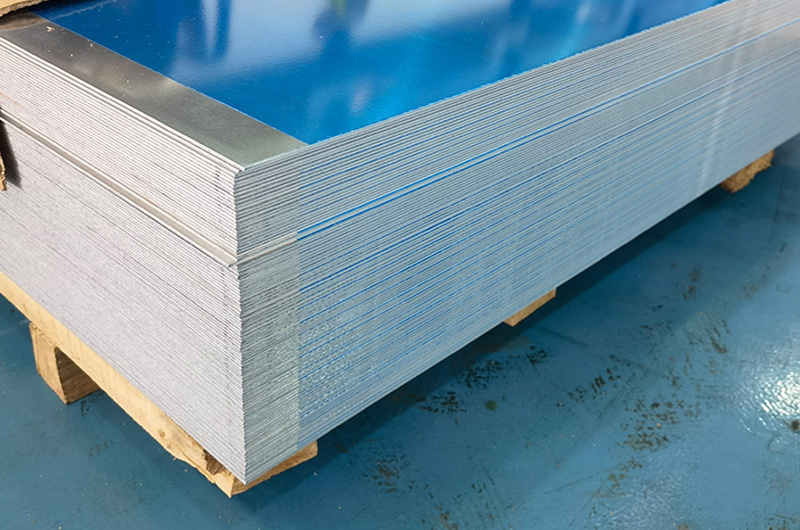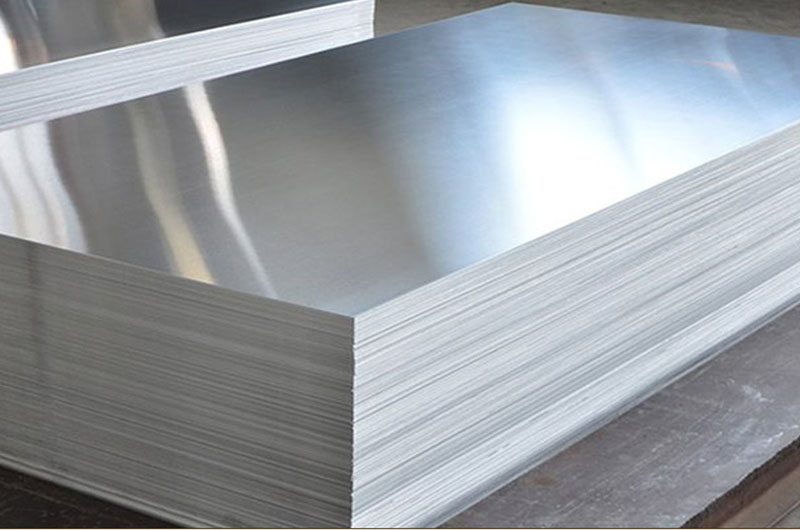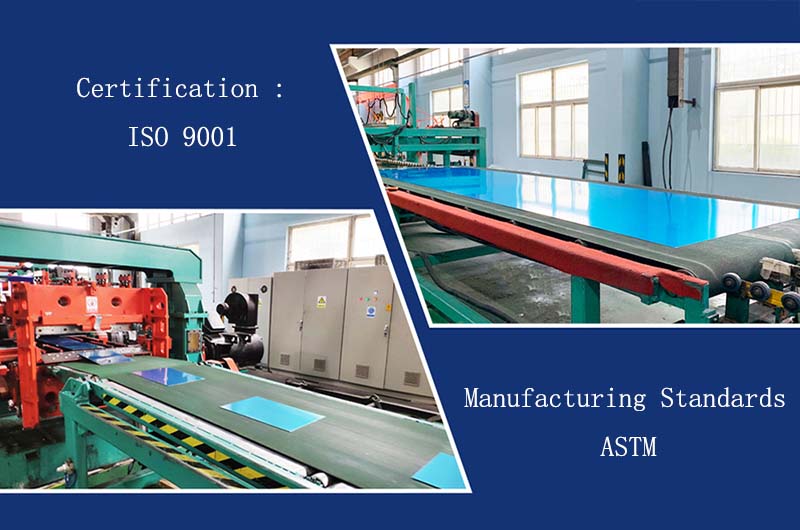5052 h38 Aluminum Plate Sheet
Dimensional Accuracy Production Standards: ASTM B209, QQ-A-250/8
What is 5052-H38 Grade Aluminum?
5052-H38 grade aluminum is a specific variation of the 5052 aluminum alloy. The "H38" temper designation indicates the specific heat treatment and mechanical properties of the material. Here are the meanings of the different elements:
- "5" in 5052: indicates that the alloy belongs to the aluminum-magnesium system.
- "0" in 5052: represents the control of impurities in the alloy. The number "0" indicates that it has no significant alloying elements other than aluminum.
- "52" in 5052: Indicates that the main alloying element in the material is magnesium. The number "52" means that the magnesium content is about 5%.

"H38" in 5052-H38: "H" stands for strain hardening, which means that the aluminum alloy has been strain hardened to improve strength. The number "38" specifies the specific tempering process and mechanical properties of the material.
The "H38" temper is achieved by annealing the aluminum alloy and then cold-working it to a specified hardness. This process increases the strength of the material while maintaining good formability.
5052-H38 aluminum plate is a high-quality aluminum alloy with a variety of properties that make it an excellent choice for road traffic signs. It's strong, lightweight and durable, ensuring it can withstand the rigors of road traffic and environmental elements.
Why Choose 5052 H38 Aluminum Plate?
Choosing a 5052 H38 aluminum plate among the various tempers of 5052 alloy depends on the specific requirements of your application. The unique advantages of the 5052 H38 aluminum plate make it the best choice in certain situations. The following are some scenarios where choosing the 5052 H38 aluminum plate has advantages:
1. 5052 H38 aluminum plate reaches higher strength levels
High Strength Requirements: If your application requires high tensile strength and structural integrity, 5052 H38 is an excellent choice. It is heat treated to achieve higher strength levels than some other states of 5052.
2. Good corrosion resistance in marine or saltwater environments
Corrosion Resistance: The superior corrosion resistance of 5052 H38 is a significant advantage when your project involves exposure to harsh environments, such as marine or saltwater conditions. It can withstand corrosion, which is critical for long-term durability.
3. 5052 H38 aluminum has good weldability
Welding and Fabrication: If your application involves welding and fabrication processes, 5052 H38 is a suitable choice. It has good weldability, is easy to form, and is suitable for various manufacturing methods.
4. 5052 H38 reduces internal stress within the material
Stress Relieved: 5052 H38 is stress relieved to reduce internal stress within the material. This is useful when dimensional stability and minimal deformation are critical in your application.
5. 5052 H38 is a lightweight option
Weight reduction: When weight reduction is critical, such as in aerospace or automotive applications, 5052 H38 is a lightweight option. It allows you to gain the strength you need while keeping weight to a minimum.
6. 5052 H38 aluminum plate has long life and low maintenance
Longevity and Low Maintenance: The combination of high corrosion resistance and durability makes 5052 H38 aluminum a good choice for applications where longevity and low maintenance requirements are important.
7. 5052 H38 is relatively easier to process
Machining Operations: If your project involves machining operations such as drilling, milling, or turning, 5052 H38 is relatively easier to machine than some other high-strength aluminum alloys.
It is important to note, however, that the choice of temper should be consistent with the specific performance criteria and environmental conditions of the project. While 5052 H38 offers many advantages, in some cases other tempers within the 5052 alloy may be more suitable.
5052 h38 Aluminum Plate Specifications
5052 h38 Aluminum Plate Thickness
The thickness of the 5052-H38 aluminum plate typically ranges from 0.016 inches (0.4064 mm) to 0.249 inches (6.32 mm).
5052 h38 Aluminum Plate Width and Length
The width and length of the 5052-H38 aluminum plate can vary depending on customer requirements and manufacturing capabilities. Common widths range from 36 inches (914.4 mm) to 72 inches (1828.8 mm), and lengths can be customized according to the application.
5052 h38 Aluminum Plate Surface Treatment
5052-H38 aluminum sheet usually comes with a mill finish, which is the standard untreated surface appearance. However, it can also be further treated with surface coatings, anodizing, or painting based on specific customer needs.

5052 h38 Aluminum Plate Certification
Common product certifications for aluminum sheet 5052-H38 include ISO 9001: 2015, which ensures that the manufacturing process complies with quality management system standards.
5052 h38 Aluminum Plate Production Standards
Aluminum Sheet 5052-H38 can be produced to various industry standards and specifications such as:
- ASTM B209: Standard Specification for Aluminum and Aluminum Alloy Sheet and Plate.
- AMS 4016: Aluminum Alloys, Plate and Plate, 2.5Mg - 0.25Cr.
- QQ-A-250/8: Federal Specification 5052 for Aluminum Alloys.
- EN 485-2: Aluminum and aluminum alloys - Plate, strip and plate.
Mechanical Properties of 5052-H38 Aluminum Plate
| Property | Typical Value |
|---|---|
| Tensile Strength | 31, 000 - 38, 000 psi (214-262 MPa) |
| Yield Strength | 21, 000 psi (145 MPa) |
| Elongation | Minimum 10% in 2-inch gauge length |
| Modulus of Elasticity | 10, 200 ksi (70, 343 MPa) |
| Hardness (Brinell) | 60 HB |
| Specified Thickness(in) | Tensile Strength - KSI | Elongationin 2 inches % | |||
| Ultimate | Yield | ||||
| Min | Max | Min | Max | ||
| 0.006 - 0.007 | 39 | - | 32 | - | 2 |
| 0.008 - 0.031 | 39 | - | 32 | - | 3 |
| 0.032 - 0.128 | 39 | - | 32 | - | 4 |
Chemical Composition of 5052-H38 Aluminum Plate
| Element | Composition Range |
|---|---|
| Aluminum (Al) | 95.7% - 97.7% |
| Magnesium (Mg) | 2.2% - 2.8% |
| Chromium (Cr) | 0.15% - 0.35% |
| Copper (Cu) | 0.1% (maximum) |
| Iron (Fe) | 0.4% (maximum) |
| Manganese (Mn) | 0.1% (maximum) |
| Zinc (Zn) | 0.1% (maximum) |
| Silicon (Si) | 0.25% (maximum) |
| Others | 0.05% (maximum) each, 0.15% (maximum) total for impurities |
What is the Difference between 5052-H32 and 5052-H38 Aluminum?
Temper Designations
- 5052-H32: The "H32" temper represents a strain-hardened and stabilized condition obtained through low-temperature heat treatment. It is typically produced by cold-working the material and then stabilizing it to a specific degree of hardness.
- 5052-H38: The "H38" temperature also indicates a strain-hardened condition but is achieved through a different heat treatment process. It involves higher-temperature stabilization compared to H32, resulting in a different combination of mechanical properties.
Mechanical Properties
- 5052-H32: The H32 temper offers moderate strength and good formability. It has a typical tensile strength ranging from 31, 000 to 38, 000 psi (214-262 MPa) and a yield strength of at least 21, 000 psi (145 MPa). This temper provides decent toughness and ductility, making it suitable for general-purpose applications.
- 5052-H38: The H38 temperature is generally harder and exhibits higher strength compared to H32. It typically offers a higher tensile strength within the range of 31, 000 to 38, 000 psi (214-262 MPa), similar to H32, but may have a slightly higher yield strength. The H38 temper is suitable for applications that require increased strength and hardness.
Note: Specific mechanical properties within a given range may vary by supplier, manufacturing process, and industry standards. The choice between 5052-H32 and 5052-H38 depends on the application requirements, the mechanical properties required, and the balance between strength and formability required for the particular application.
-
5052 Aluminum Plate Sheet
5052 aluminum plate is mainly composed of magnesium and chromium. It has good processability, medium static strength, high fatigue strength, and good weldability. The fatigue strength of 5052 aluminum alloy is higher than most aluminum alloys.
-
5052 h32 Aluminum Plate Sheet
5052 H32 aluminum plate has higher fatigue strength than most alloys, 5052H32 aluminum plate has excellent corrosion resistance, especially in marine applications, and has excellent machinability.
-
5052 h34 Aluminum Plate Sheet
5052 h34 aluminum plate has enhanced corrosion resistance, workability, strength, good formability and weldability.
Common Problems Encountered in the Production of 5052 H38 Aluminum Plates
The production of 5052 H38 aluminum plate, like any manufacturing process, may encounter various issues that may affect the quality and consistency of the final product. The following are some common problems encountered in the production of 5052 H38 aluminum plates:
1. Surface Defects
Surface imperfections such as scratches, dents, or marks may occur during handling, rolling, or cutting. These defects can affect the appearance and integrity of 5052 H38 sheets.
2. Side Crack
During the rolling process, if the tension is too high or the rolling parameters are improperly controlled, edge cracks will occur. It may cause 5052 H38 material waste and reduce product quality.
3. Waviness
5052 H38 plate may have corrugations or ripples on its surface due to uneven rolling or cooling. This may result in non-slabs that are unsuitable for certain applications.
4. Inclusions
The inclusion of foreign objects or impurities can cause weak spots in 5052 H38 aluminum sheets. These inclusions may come from raw materials or production equipment.
5. Porosity
Porosity refers to the presence of small voids or air pockets within the aluminum plate. It can occur during casting or solidification and weaken the material.
6. Cracking
If the process is not properly controlled, cracking may occur within the plate during quenching or cooling. This can also occur due to improper storage or handling.
7. Dimensional Changes
Inconsistent thickness or size of 5052 H38 plate can be a common problem if the rolling process is not properly controlled. This may result in the board not meeting the specified tolerances.
8. Surface Oxidation
5052 H38 aluminum is susceptible to surface oxidation, which can result in a dull or rough surface. Proper surface preparation and storage conditions are essential to prevent oxidation.
9. Changes in Chemical Composition
The chemical composition of 5052 H38 aluminum alloy may change if the raw materials are not properly controlled. This can lead to inconsistent mechanical properties.
10. Uneven Tempering
Achieving the desired tempered state, such as H38, requires precise control of the heat treatment process. Inconsistent tempering can result in boards with different hardness and strength levels.
11. Rolling Defects
Problems with rolling mill equipment or processes can cause defects such as surface ridges, pits, or uneven thickness. Regular maintenance and calibration are essential to prevent these problems.
12. Metal Pollution
Contamination from equipment or foreign matter can introduce impurities into the aluminum, affecting its performance and causing defects.
13. Heat Treatment Issues
Improper heat treatment process or temperature control may cause problems such as poor mechanical properties of 5052 H38 or improper tempering specification.
To mitigate these common problems, strict quality control measures must be implemented, equipment maintained, and production parameters carefully monitored and adjusted. Regular inspections, testing, and compliance with industry standards and specifications are critical to ensuring the production of high-quality 5052 H38 aluminum plates.
High-quality 5052 h38 Aluminum Plate Supplier
Haomei Aluminum is a high-quality 5052 H38 aluminum plate supplier.
- Product Quality: Provide high-quality aluminum plates that meet or exceed industry standards. The aluminum plate has consistent dimensions, surface finish, and mechanical properties.
- Manufacturing Standards: Comply with recognized aluminum sheet manufacturing standards such as ASTM (American Society for Testing and Materials) or international equivalents. Adherence to these standards ensures consistent product quality and reliability.
- Certification and accreditation: e.g. ISO 9001 (Quality Management Systems) certification.
- Flexibility and customization: According to your specific requirements, we can provide customized solutions, such as different sizes, surface treatments, or packaging options, to meet customer needs.
- Competitive Prices: While price should not be the only deciding factor, we offer competitive prices that match the market value of aluminum sheets.

5052 h38 Aluminum Plate Sheet Stock Lists
| Product | Width (In.) | Length (In.) |
| .080" 5052 H38 aluminum sheet plate | 30" | 96" |
| .080" 5052 H38 aluminum sheet plate | 30" | 120" |
| .080" 5052 H38 aluminum sheet plate | 30" | 144" |
| .080" 5052 H38 aluminum sheet plate | 36" | 96" |
| .080" 5052 H38 aluminum sheet plate | 36" | 120" |
| .080" 5052 H38 aluminum sheet plate | 36" | 144" |
| .080" 5052 H38 aluminum sheet plate | 48" | 96" |
| .080" 5052 H38 aluminum sheet plate | 48" | 120" |
| .080" 5052 H38 aluminum sheet plate | 48" | 144" |
| .125" 5052 H38 aluminum sheet plate | 30" | 96" |
| .125" 5052 H38 aluminum sheet plate | 30" | 120" |
| .125" 5052 H38 aluminum sheet plate | 30" | 144" |
| .125" 5052 H38 aluminum sheet plate | 36" | 96" |
| .125" 5052 H38 aluminum sheet plate | 36" | 120" |
| .125" 5052 H38 aluminum sheet plate | 36" | 144" |
| .125" 5052 H38 aluminum sheet plate | 48" | 96" |
| .125" 5052 H38 aluminum sheet plate | 48" | 120" |
| .125" 5052 H38 aluminum sheet plate | 48" | 144" |
People also searched for Aluminum Plate
-
5005 Aluminum Plate Sheet
5005 aluminum is a medium-strength aluminum alloy with a small amount of magnesium as the main alloying element. It has good formability and is often used in applications requiring anodized surface treatments.
-
5005 h32 Aluminum Plate Sheet
5005-H32 aluminum is 5005 aluminum in the H32 condition. To achieve this state, the metal is strain-hardened and then stabilized to about one-fourth the strength between annealed (O) and fully hard (H38).
-
5005 h34 Aluminum Plate Sheet
5005 H34 aluminum has stable properties, it can stabilize mechanical properties and eliminate residual internal stress, and generally improves ductility.

